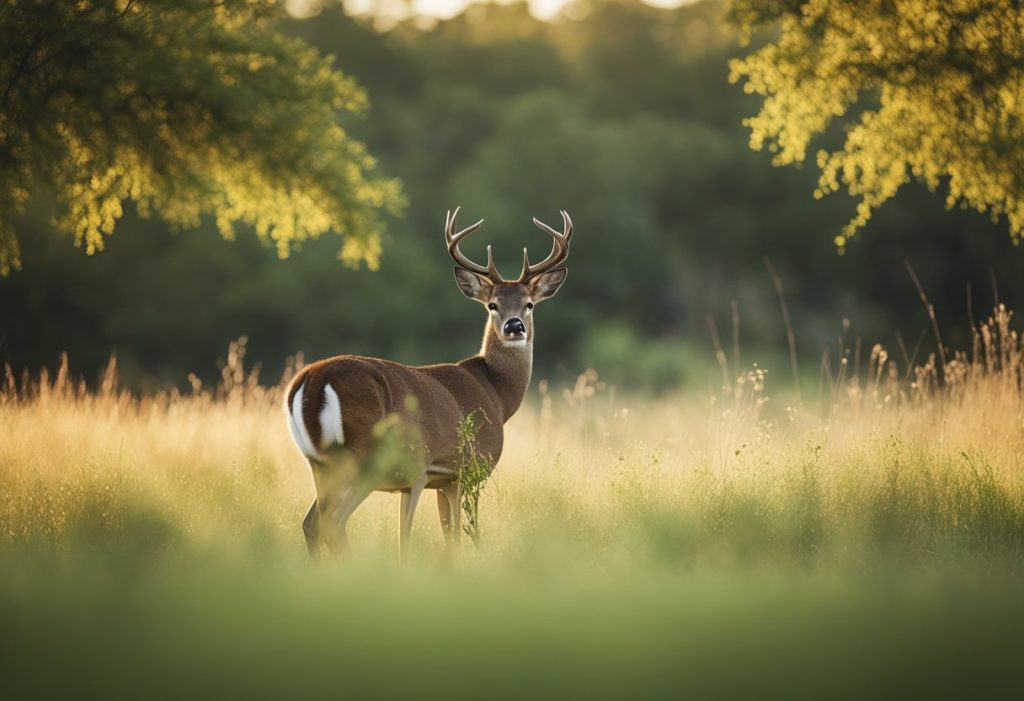Texas is home to a diverse range of wildlife, from white-tailed deer to wild turkey, and the state’s wildlife management efforts play a crucial role in maintaining healthy populations. Wildlife management in Texas is overseen by the Texas Parks and Wildlife Department (TPWD), which is responsible for managing and conserving the state’s natural resources.

One of the primary goals of wildlife management in Texas is to ensure that wildlife populations are sustainable and healthy. This involves monitoring population levels, managing habitat, and regulating hunting and fishing activities. The TPWD works closely with landowners, hunters, and other stakeholders to develop and implement management plans that are tailored to the unique needs of each species and ecosystem.
In recent years, wildlife management in Texas has become increasingly important as the state’s population continues to grow and development encroaches on natural habitats. The TPWD has responded by expanding its conservation efforts and partnering with private landowners to protect and restore habitat. Through these efforts, Texas has become a national leader in wildlife management and conservation, and continues to set an example for other states to follow.
Wildlife Management Principles

Wildlife management is the practice of maintaining and conserving wildlife populations and their habitats. In Texas, there are several principles that guide wildlife management practices to ensure the sustainability of wildlife populations.
Conservation Strategies
Conservation strategies are a critical aspect of wildlife management in Texas. Wildlife conservation involves the protection and preservation of wildlife and their habitats. There are several conservation strategies used in Texas, including habitat conservation, restoration, and enhancement. These strategies aim to protect and restore habitats that are vital to the survival of wildlife populations.
Habitat Enhancement Techniques
Habitat enhancement techniques are used in Texas to improve the quality of habitats for wildlife. These techniques include the creation of food plots, water sources, and nesting sites that are essential for the survival of wildlife populations. Habitat enhancement techniques are often used in conjunction with conservation strategies to ensure the sustainability of wildlife populations.
Population Monitoring
Population monitoring is an essential aspect of wildlife management in Texas. It involves the collection of data on wildlife populations to track changes in their numbers and distribution. This information is used to make informed decisions about wildlife management practices, such as hunting regulations, habitat conservation, and population control measures.
Overall, wildlife management in Texas is focused on enhancing and conserving wildlife populations and their habitats. By implementing conservation strategies, habitat enhancement techniques, and population monitoring, wildlife managers can ensure the sustainability of wildlife populations and the benefits they provide to the ecosystem.
Land Stewardship and Landowner Resources

Wildlife management in Texas is a collaborative effort between the state, landowners, and stewards of private lands. Land stewardship is a crucial aspect of wildlife management, and it involves managing and conserving land to support wildlife populations. Landowners are essential in this process as they own a significant portion of the land in Texas. The Texas Parks and Wildlife Department provides technical guidance and resources to landowners to help them manage their land for the benefit of wildlife.
Technical Guidance for Landowners
The Texas Parks and Wildlife Department offers technical guidance to landowners on various aspects of land management. This guidance includes information on habitat management, wildlife surveys, and control of invasive species. Landowners can also receive assistance in developing management plans for their property to improve habitat quality and increase wildlife populations.
Grazing and Land Use
Grazing is a common land use practice in Texas, and it can have both positive and negative impacts on wildlife. Proper grazing management can improve habitat quality for wildlife by promoting the growth of native vegetation. The Texas Parks and Wildlife Department provides information on grazing management practices that benefit both livestock and wildlife.
Prescribed Burning and Food Plots
Prescribed burning and food plots are other management practices that can benefit wildlife. Prescribed burning can promote the growth of native vegetation and improve habitat quality for wildlife. The Texas Parks and Wildlife Department provides information on safe and effective prescribed burning practices.
Food plots are areas of land planted specifically to provide food for wildlife. They can be used to supplement natural food sources and attract wildlife to specific areas. The Texas Parks and Wildlife Department provides information on the best types of plants to use in food plots and how to manage them for maximum benefit to wildlife.
In conclusion, land stewardship is essential to wildlife management in Texas, and landowners play a crucial role in this process. The Texas Parks and Wildlife Department provides technical guidance and resources to help landowners manage their land for the benefit of wildlife. Proper grazing management, prescribed burning, and food plots are just a few of the practices that landowners can use to improve habitat quality and increase wildlife populations.
Regulations and Permitting
Hunting Laws and Permits
Hunting in Texas is regulated by the Texas Parks and Wildlife Department (TPWD). The department has established rules and regulations to ensure the safety of hunters and the sustainability of wildlife populations. Hunters are required to obtain a hunting license and any necessary permits before hunting in Texas.
The TPWD offers a variety of hunting permits, including general hunting, archery hunting, and youth hunting permits. Some species, such as white-tailed deer and turkey, require special permits and tags. Hunters are required to follow bag limits and hunting season dates, which vary by species and location.
Wildlife Management Area Rules
Texas has over 1 million acres of public hunting land, managed by the TPWD as Wildlife Management Areas (WMAs). WMAs are open to public hunting, but hunters must follow specific rules and regulations.
Hunters are required to obtain a hunting permit and follow bag limits and season dates. Some WMAs have additional rules, such as specific hunting methods or restrictions on the use of certain equipment. Hunters are also required to follow safety regulations, such as wearing hunter orange during certain hunting seasons.
In addition to hunting regulations, WMAs have rules for other activities such as camping and hiking. These rules are designed to protect wildlife and ensure the safety of visitors.
Research and Education
Ongoing Wildlife Research
Texas is home to a diverse range of wildlife species, and managing their populations requires ongoing research. Biologists and natural resource professionals in Texas are constantly conducting research to better understand the behavior, habitat, and population dynamics of various wildlife species. This research is essential in developing effective management strategies that ensure the long-term sustainability of these species.
Some ongoing research projects in Texas include studying the migration patterns of birds, tracking the movements of large mammals like deer and elk, and monitoring the populations of endangered species such as the red-cockaded woodpecker. These studies provide valuable insights into the ecology of these species and help inform management decisions.
Educational Programs and Extension
In addition to research, education is also a critical component of wildlife management in Texas. The Texas A&M AgriLife Extension Service provides educational programs and resources for landowners, natural resource professionals, and the general public. These programs cover a wide range of topics, including wildlife management, habitat restoration, and conservation.
The Extension Service also offers training and certification programs for individuals interested in pursuing careers in wildlife management. These programs provide hands-on experience and practical skills that are essential for success in this field.
Overall, ongoing research and education are vital components of wildlife management in Texas. By staying up-to-date on the latest research and best practices, biologists and natural resource professionals can develop effective strategies that ensure the long-term sustainability of Texas’s diverse wildlife species.
Contact and Support
Connecting with Texas Parks and Wildlife
If you have any questions or concerns about wildlife management in Texas, the Texas Parks and Wildlife Department is available to assist you. You can contact them via phone, email, or in-person at their headquarters in Austin, TX. The department’s website also provides a wealth of information on wildlife management, including regulations, permits, and educational resources.
To contact Texas Parks and Wildlife, you can visit their website at www.tpwd.texas.gov and click on the “Contact Us” tab. From there, you can find contact information for various departments within the agency, as well as links to their social media accounts.
Supporting Wildlife Management Efforts
There are many ways to support wildlife management efforts in Texas, including volunteering, donating, and participating in educational programs. Texas Parks and Wildlife offers a variety of volunteer opportunities, such as habitat restoration, wildlife surveys, and public outreach events.
If you are interested in donating to support wildlife management in Texas, you can do so through the Texas Parks and Wildlife Foundation. The foundation supports a variety of conservation projects, including land acquisition, habitat restoration, and wildlife research.
In addition, Texas Parks and Wildlife offers a variety of educational programs for all ages, including workshops, field trips, and online resources. These programs provide valuable information on wildlife management and conservation, and help to promote a greater understanding and appreciation of Texas’s diverse wildlife.
Frequently Asked Questions
What are the regulations for wildlife management in Texas?
Texas Parks and Wildlife Department (TPWD) is responsible for managing and protecting the state’s wildlife resources. The department has established regulations for hunting, fishing, and trapping in Texas. These regulations are designed to ensure the sustainability of wildlife populations and their habitats. It is important for individuals to review and follow these regulations when engaging in wildlife management activities.
How does one qualify for a wildlife management exemption in Texas?
In Texas, landowners may qualify for a wildlife management exemption if they meet certain criteria. To qualify, the landowner must have a wildlife management plan that meets TPWD’s standards. The plan must address specific habitat management practices, such as prescribed burning, brush management, and water development. Additionally, the landowner must have a history of wildlife management on the property and allow public hunting access.
Which agency is responsible for wildlife conservation in Texas?
The Texas Parks and Wildlife Department is responsible for wildlife conservation in Texas. The department’s mission is to manage and conserve the natural and cultural resources of Texas and to provide hunting, fishing, and outdoor recreation opportunities for the use and enjoyment of present and future generations.
Where can I find a map of Wildlife Management Areas in Texas?
TPWD manages over 1.4 million acres of public land in Texas, including wildlife management areas (WMAs). A map of WMAs in Texas is available on the department’s website. The map provides information about the location, size, and amenities of each WMA.
What educational courses are available for wildlife management in Texas?
TPWD offers a variety of educational courses for individuals interested in wildlife management. These courses cover topics such as habitat management, wildlife biology, and hunting safety. TPWD also offers workshops and training sessions for landowners and wildlife professionals.
What degree programs are offered in Texas for wildlife management?
Several universities in Texas offer degree programs in wildlife management, including Texas A&M University, Texas Tech University, and Sul Ross State University. These programs provide students with the knowledge and skills necessary to manage wildlife populations and their habitats.